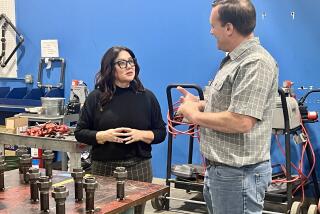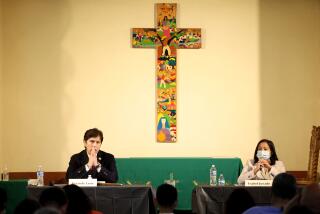Labor Has Learned How to Tango
- Share via
In a surprise move, the Los Angeles County Federation of Labor, the umbrella group for union labor in the city, gave Republican Mayor Richard Riordan its stamp of approval by endorsing him for a second term over rival Tom Hayden.
On the surface, labor’s action seems confusing and counterintuitive. Hayden, a liberal Democrat, has been a firm supporter of labor’s agenda in the California Assembly and Senate. Riordan, on the other hand, never has been a strong labor backer and has opposed crucial elements of labor’s agenda including the “living wage” proposal currently before city council.
Additionally, the labor movement is attempting a revival that is focused on a renewed militancy. At a recent speech at UCLA, AFL-CIO head John Sweeney told a large crowd that labor had to extend a hand to the poor, community organizations and other progressive groups as a necessary component of labor’s potential resurgence. If this is the case, how could labor issue a recommendation for a mayor who has often been at odds with labor’s program.
Part of the answer can be found in the labor movement’s disparate structure. Organized labor is made up of a wide array of unions, some organized in the private sector, others in the public sphere, some in service industries and others in the professions. While there often is consensus on overall philosophy, the particular interests of individual unions may diverge. The building trades unions, for instance--carpenters, pipe-fitters, cement masons--saw in Riordan an ally who favors projects like the downtown arena and the LAX expansion that will put their members to work. Hayden opposes these projects, a position that puts him at odds with the construction unions.
But ironically, one of the people who supported Riordan in the endorsement vote was the militant leader of the Hotel and Restaurant Workers Local 11, Maria Elena Durazo, clearly not a member of the white, bureaucratized, union leadership of Hayden’s characterization. But like other labor leaders who also extracted concessions from Riordan, she was faced with the necessity of consolidating some gains for her union and membership from a political process that she does not control. Riordan gained Durazo’s support after committing to intervene in the hotel employees’ two-year conflict over union representation at the Japanese-owned New Otani Hotel and by suggesting that he would help Local 11 when its citywide hotel negotiations begin next year
And for the first time, Riordan told labor at the endorsement meeting, he would not veto the “living wage” ordinance when, as is expected, it is approved by the City Council.
Riordan’s current relationship with Durazo is a stark contrast from 1992, when Durazo orchestrated her “City On the Edge,” campaign designed to deter tourists from vacationing in Los Angeles by suggesting that the city was on the verge of social chaos. Riordan does not want a repeat of 1992, and Durazo needs some concrete victories that will consolidate her local in a capricious hotel industry.
Through a series of brilliant political maneuvers combined with a realistic assessment that Riordan is likely to be mayor for another four years, he unexpectedly received labor’s support. But the critical question is whether Riordan’s preelection commitments are sustainable in a postelection environment.
More fundamentally, can labor lead a broader movement for social and economic change after endorsing a politician seen as antithetical to the values and goals of the groups that labor needs to coalesce with?
The County Federation of Labor has a dual task: Transform labor’s organizational and political culture and at the same time obtain the best deal possible within the current political alignment. Clearly, meeting that challenge will not be graceful. What we witnessed through the labor federation’s endorsement process is the beginning of a protracted struggle over whether Los Angeles, for decades the prototype of the open-shop metropolis, will become a union city. That dynamic will take years to play itself out.
In the meantime, local labor can do a number of things to rebuild frayed alliances and repair an organizational fault line. The construction unions should emerge as outspoken opponents of privatizing city workers’ jobs, the main issue of contention between Riordan and the city employee unions. A second major task is intellectual. The labor movement should develop a comprehensive analysis and program for Los Angeles that includes progressive proposals for housing, taxation, transportation, welfare reform and environmental policy. It is the most effective way to put labor’s motto of “An injury to one is an injury to all,” into practice.
More to Read
Sign up for Essential California
The most important California stories and recommendations in your inbox every morning.
You may occasionally receive promotional content from the Los Angeles Times.










